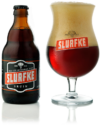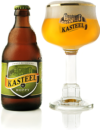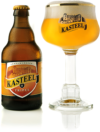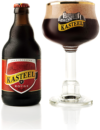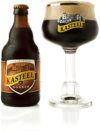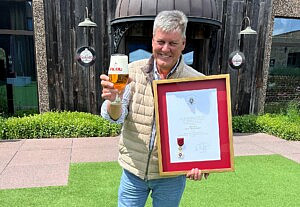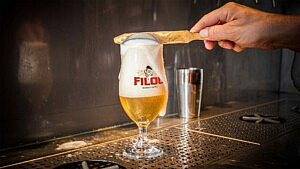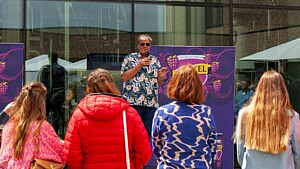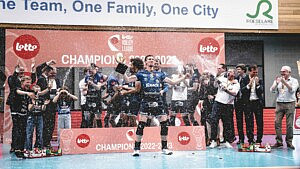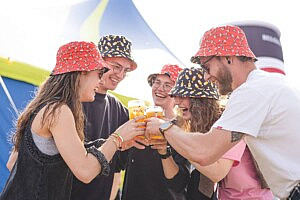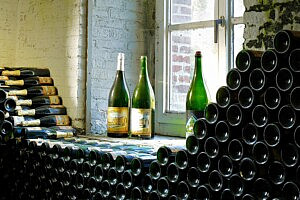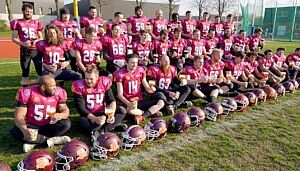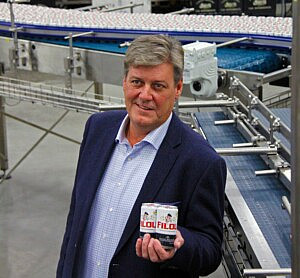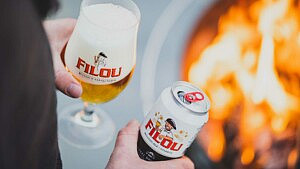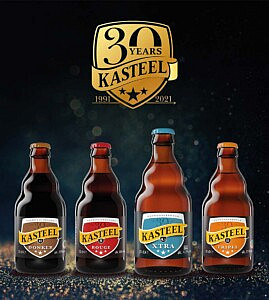On the eve of the national holiday in Belgium (July 21), the Belgium king presents marks of honor to deserving national citizens. This year, Xavier Vanhonsebrouck received one. Our CEO received the title “Officer of the Order of the Crown” for his services rendered to the business community. The certificate and accompanying medal can be ... Read More
Van Honsebrouck
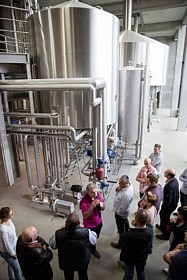
Van Honsebrouck is a Belgian brewery in Ingelmunster, Belgium. Founded in 1865 as Sint-Jozef Brewery, it was renamed to Brewery Van Honsebrouck in 1953. It is one of two breweries outside of Pajottenland to produce lambic beer.
“On 1st January 2009, at the ripe old age of 79, Luc Van Honsebrouck passed on the mashing stick to his son Xavier (born 1967). By that time, Xavier had been working within the brewery for over 20 years, primarily in sales and exports and then gradually taking over management duties from his father. Times have changed. When “mister Luc” was in charge of the brewery, visiting journalists were received by the brewmaster or a member of the marketing team. Only at the end of the tour would Luc make an appearance in the tasting room to offer a round. These days it is Xavier himself who welcomes the guests, makes a pot of coffee and pours the beer.
“Do you know what the numbers 7 – 4 – 2 stand for?” Xavier asks. “I am the seventh brewer in the Van Honsebrouck family, the fourth to wield the mashing stick and the second one who only produces specialty beers.”
History
The founder of the Van Honsebrouck brewing dynasty was Amandus (1811 – 1865). He was the mayor of the village of Werken, where he owned a farm that included a dairy, a brewery and a distillery. Amandus passed away suddenly and was succeeded by his son Emile (1844 – 1929) as both brewer and mayor (until 1878). In 1863 Emile married Louise De Poorter, who came from Ingelmunster. The young couple moved into the family farm in Werken. However, Louise did not get on with her mother-in-law and the grandchildren were not warmly welcomed. Emile and Louise left the village of Werken to start up their own breweries, first in Vichte, then in Kortrijk. Neither venture was a success. In 1900 the Van Honsebrouck – De Poorters moved into a modest farm on the outskirts of Ingelmunster and the little Sint Jozef brewery was born.
Ingelmunster
Emile was not cut out to be in charge of a brewery, and so Louise found herself looking after the beer as well as a household with five children. In 1922, when Emile was pushing 80, ‘merke’ – as Louise’s children called her – entrusted the brewery to her son Paul. He took up the mashing stick jointly with Ernest, his older brother. Together, the brothers managed to keep the brewery going after the destruction wrought by the First World War. Ernest belittled his own brewing skills: “I was taught how to brew by my brother Paul, who learnt from ‘our’ Dad, who couldn’t really do it either!” Nevertheless, the pair successfully expanded the brewery in 1930. A new four-storey building was added, comprising a maltings, water basins and storage facilities for barley. The ground floor was used for the great storage barrels: 15 foeders with a capacity of between 18,000 and 25,000 hectolitres each. The renovation concluded in 1939 with the addition of a new brewing hall, tank hall and bottling plant. To fund the expansion, the brothers had come to a splendid agreement with a building contractor, Crop from Meulebeke. Fifty percent of the work would be paid for in cash and the other half ‘in natura’, in other words, in beer. Paul and Ernest brewed bottom-fermented beers: bock, export and pils. The changeover to the production of this type of beer took a great deal of money and effort but did not exactly set the tills ringing. At all times though, the brothers honoured their promise to ‘merke’ Louise, who asked of them: “As long as I live, there are two things you must not do: stop brewing or go bankrupt. But once I’m dead, you can do whatever you want.” Ernest remained a bachelor all his life. Paul married Germana Ampe and the marriage produced eight children. The plan was that Marc, one of the younger sons, would take over the brewery. However, father Paul contracted a serious illness at a relatively young age and the family feared for his life. One of the older sons, Luc (born 1930), seized his opportunity and started to study to become a brewer. During the holidays, the four sons would help out at the brewery, mainly sticking on labels. After one year at the brewery school Luc was fed up with the sticky stuff. He was allowed to join other breweries as a trainee to expand his knowledge. One of his main postings was with the Wicküler – Kupperbrauerei in Wuppertal in Germany, where he learnt that order, hygiene and discipline are essential ingredients for brewery management. Once Luc had finished his studies he was ready to take over at the family firm.
Luc
When, in 1953, Luc Van Honsebrouck took his first managerial steps at the Sint Jozef brewery, the range comprised brown table beer, export, pils and oud bruin, a regional beer from Western Flanders. Luc soon realised that his small family brewery wasn’t able to compete with the large pils breweries. He decided to concentrate on the production of an oud bruin, naming it Bacchus in 1954. Barely one year on, Luc decided to stop brewing pils and, for good measure, the Sint Jozef name was dropped for Van Honsebrouck. Luc did want to continue selling pils in his own cafés, so he concluded an exchange deal with the Eeklo-based Krüger brewery. They would offer Bacchus in their cafés and he would sell Krüger Pils in his. The Bacchus sold very well but the Krüger didn’t. Bacchus experienced its first real breakthrough around 1975, when demand for Rodenbach, a similar beer, exceeded the supply that its eponymous brewery could manage. Bacchus production was stepped up to 2,500,000 litres per annum. It is impossible for a brewery to survive on the production of just one beer. And when, in the early 1950s, Belle Vue Gueuze became popular, father Paul started distributing it. To start off, he purchased 20 crates, which turned into 50 and finally, 100. The success of this venture gave Luc the idea to create a second specialty beer. Bacchus was to be joined by a Van Honsebrouck gueuze. The ingredients and the brewing method did not pose any particular problems. But: how do you transfer the wild yeasts needed for spontaneous fermentation from the valley of the Zenne to Ingelmunster, which is about 100 kilometres away? The solution was simple: in 1957 Van Honsebrouck bought lambic wort from Van Haelen Frères in Uccle. In their cooling basin this wort had been permeated with the ambient microflora and, one day later, it was transported by road to Ingelmunster. There, the wort was pumped into the foeders used to mature the Bacchus and blended with wort from the brewery. Luc then transferred the yeast culture from one foeder to the next and thus, based on a relatively small quantity of wort purchased elsewhere, he managed to produce sufficient lambic to feed his own gueuze and kriek.
Barista Chocolate Quad

- Style: Chocolate or Cocoa Beer, Coffee Beer, Dark Strong Ale
- Alcohol Content: 11%
- Global Rating:
Bacchus Flemish Old Brown

- Style: Belgian Style, Flemish Old Brown
- Alcohol Content: 4.5%
- Global Rating:
Kasteel USA: “Making Kasteel beer affordable for and accessible to the average American’”
Patience is a virtue. In this case, the virtue is the return of Kasteel to the United States of America. Our subsidiary Kasteel USA had a difficult start because of the corona pandemic. Now that all the pieces of the puzzle have fallen into place, the American Dream can start to become a reality. The ... Read More
After almost 10 years, Filou is rolling out a new identity
In 2024, our beer brand Filou will blow out 10 candles. A decade of Filou. That deserves a new look and feel. So, our mascot underwent a mini makeover. With the new identity, we are also highlighting the sportive character of our Filou. vs A new look Filou has had a mini facelift. The cheeky ... Read More
Launch of Kasteel Rubus Framboise: ‘We are the authority in the strong fruit beer segment.’
NEW: Kasteel Rubus Framboise (7%), the eternal summer beer. CEO Xavier Vanhonsebrouck and the Sales and Marketing team explain our latest taste innovation. Xavier Vanhonsebrouck (CEO):’Our brewery’s future is secured.’ When our competitors try to emulate us, we have to be ready with something new. That’s what I told the production department a year and ... Read More
Filou looks back on the 2022-2023 sports season
Nail-biting: that’s perfect way to sum up this past sports season. Both the Tomabelhal in Roeselare as well as the COREtec Dôme in Ostend formed the backdrop to many thrilling matches. Even closer to home, HBC Izegem was promoted to the BENE Handbal League for the very first time. Unfortuntely, KV Oostende didn’t score as ... Read More
Kasteel at the Festivals: a look at the 2023 festival summer
Play Video There are no festivals without summer and no festivals without Kasteel. This year again, Kasteel is completing the lineup at various events. Gareth Linskens, Events & Hospitality Manager, takes you to the festivals and guides you through the ‘Kasteel at the Festivals’ summer schedule. We are starting with a premiere. We are the ... Read More
New Kasteel beer serves summer throughout the year
The seasons are not what they used to be. That’s why Kasteel Brouwerij Vanhonsebrouck resolutely chooses summer. With Kasteel Rubus Framboise (7%), the family brewery from Izegem is introducing a brand-new taste sensation based on real raspberries. CEO Xavier Vanhonsebrouck describes his latest innovation as the eternal summer beer. ‘Like many people, I feel at ... Read More
Kasteel Xtra (4.5%): low in alcohol, full of flavour and Xtra moments
Play Video From dancing round a campfire on a sultry summer evening to a wild night that doesn’t end until the sun comes up: relive your wild years with Kasteel Xtra (4.5%). Kasteel is a rich and, above all, highly varied beer brand. We have a tasty Kasteel beer ready for any occasion. Enjoy a ... Read More
The making of Kasteel, you find true richness everywhere
From our family brewery in Izegem, Kasteel creates moments of true richness worldwide. Around our beer brand’s 30th birthday, our CEO Xavier Vanhonsebrouck had the ambitious plan of portraying the impact Kasteel has on people. Xavier found a like-minded partner in Geronimo, a production company that makes high-end television, films and adverts. Kasteel turned 30 ... Read More
Can you store Kasteel Donker beer?
Did you know that you can drink Kasteel Donker up to five years after its bottling date? Even though you can take this expiration date with a big grain of salt. Let our dark beer ripen using the tips below and become an expert at storing beer. Before we serve our storage tips, it is ... Read More
Kasteel Brouwerij Vanhonsebrouck expands annual capacity by 25,000 hl
Play Video IZEGEM – Major works on the site of the Bierkasteel in Izegem. Kasteel Brouwerij Vanhonsebrouck installed an additional three beer tanks there. This new investment of over 1 million provided the brewery with a capacity expansion of 12.5%. Production manager Hans Mehuys: ‘This year we are aiming for 15% growth compared to 2021. ... Read More
The Low Countries discover American sports culture through Kasteel Nitro
Play Video The Super Bowl is a household name in the world of sports. This event also rings a bell for us, even though American football is not very well known in our region. We are happy to change that. In fact, Kasteel Nitro is bringing the American sports culture to the Low Countries. Making ... Read More
Hot off the press: overview of press articles about Kasteel Brouwerij Vanhonsebrouck
Whenever our brewery or one of our beers makes an appearance in the press, you can find a link to the article here. 04/03/2022 – Het Nieuwsblad Oorlog heeft ook gevolgen voor export bier en import grondstoffen: “Ze zouden beter bierblikjes droppen in plaats van bommen” Read the article here 01/03/2022 – De Tijd “Die ... Read More
New in Sweden: Filou cans
If you have ever visited Sweden, Norway or Finland, you will know that alcoholic drinks don’t come cheap there. It is therefore difficult to launch Belgian speciality beers with a high alcohol content in these markets. Difficult, but not impossible, Brouwerij Vanhonsebrouck said to itself. “Our Filou can currently be found in around 270 supermarkets ... Read More
Private: New in Sweden: Filou cans
If you have ever visited Sweden, Norway or Finland, you will know that alcoholic drinks don’t come cheap there. It is therefore difficult to launch Belgian speciality beers with a high alcohol content in these markets. Difficult, but not impossible, Brouwerij Vanhonsebrouck said to itself. “Our Filou can currently be found in around 270 supermarkets ... Read More
New in Sweden: Filou cans
If you have ever visited Sweden, Norway or Finland, you will know that alcoholic drinks don’t come cheap there. It is therefore difficult to launch Belgian speciality beers with a high alcohol content in these markets. Difficult, but not impossible, Brouwerij Vanhonsebrouck said to itself. “Our Filou can currently be found in around 270 supermarkets ... Read More
New in Sweden: Filou cans
If you have ever visited Sweden, Norway or Finland, you will know that alcoholic drinks don’t come cheap there. It is therefore difficult to launch Belgian speciality beers with a high alcohol content in these markets. Difficult, but not impossible, Brouwerij Vanhonsebrouck said to itself. “Our Filou can currently be found in around 270 supermarkets ... Read More
Kasteel Brouwerij Vanhonsebrouck partners up with Eneco for green energy
From canned beer to a roof full of solar panels: as Europe’s most modern brewery, we are reducing our ecological footprint step by step. For our most recent investment, we turned to energy supplier Eneco. Our brewery complex in Izegem is called Bierkasteel, which translates as ‘Beer Castle’. This modern building is the eye-catcher of ... Read More
Kasteel Brouwerij Vanhonsebrouck partners up with Eneco for green energy
Play Video From canned beer to a roof full of solar panels: as Europe’s most modern brewery, we are reducing our ecological footprint step by step. For our most recent investment, we turned to energy supplier Eneco. Our brewery complex in Izegem is called Bierkasteel, which translates as ‘Beer Castle’. This modern building is the ... Read More
Anniversary label and new Kasteel beer to mark thirty years of Kasteel
Play Video Kasteel beer has been in existence for thirty years – and we’re celebrating that! Until the end of this year, we’re giving our Kasteel Donker, Kasteel Tripel and Kasteel Rouge a festive sleeve. And to make the celebrations extra special, we’ve also added a new member to the Kasteel family. We all need ... Read More



